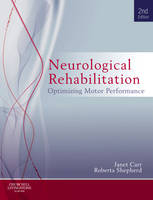
Neurological Rehabilitation
Optimizing motor performance
Seiten
2010
|
2nd edition
Churchill Livingstone (Verlag)
978-0-7020-4051-1 (ISBN)
Churchill Livingstone (Verlag)
978-0-7020-4051-1 (ISBN)
Looks at the advances that have occurred in the understanding and treatment of adults with neurological conditions. This title outlines training guidelines that are based on biomechanical constructs and motor relearning research, applied to enhance brain reorganization and muscle contractility, and encourage functional recovery of the patient.
Janet Carr and Roberta Shepherd head up a new team of eminent authors for the second edition of this definitive text on neurological physiotherapy. In the first edition, the authors described a model of neurological rehabilitation for individuals with motor dysfunction based on scientific research in the areas of neuromuscular control, biomechanics, motor skill learning, and the link between cognition and action, together with developments in pathology and adaptation.
The new edition continues to advance this model while identifying and incorporating the many advances that have occurred in the last decade in the understanding and treatment of adults with neurological conditions, whether caused by accident or disease. Among these advances is the knowledge that the brain retains a plastic potential to reorganize, even in old and/or lesioned brains, and that neural plasticity can be influenced by task-related mental and physical practice in a stimulating environment. There is also an increasing body of knowledge related to the musculoskeletal system's adaptability and the need to prevent length and stiffness- related changes in muscle contractility, together with loss of aerobic fitness and endurance. There is an expanding body of clinical research that appears to support the model provided here. The training guidelines outlined in Neurological Rehabilitation are based on biomechanical constructs and motor relearning research, applied to enhance brain reorganization and muscle contractility, and encourage functional recovery of the patient. It connects science and clinical practice enabling students and practitioners to develop their knowledge and use new clinical methods based on modern scientific understanding.
All chapters have been revised, some with the collaboration of five specialists who are engaged in high level scientific research and clinical practice
Biomechanical models are presented to provide a framework for action-specific training and exercise to improve performance
Clinical guidelines are science- and evidence-based
Emphasis is on new approaches to the delivery of neurological rehabilitation that increase the time spent in mental and physical activity, and the intensity of practice and exercise
Up-to-date referencing
Janet Carr and Roberta Shepherd head up a new team of eminent authors for the second edition of this definitive text on neurological physiotherapy. In the first edition, the authors described a model of neurological rehabilitation for individuals with motor dysfunction based on scientific research in the areas of neuromuscular control, biomechanics, motor skill learning, and the link between cognition and action, together with developments in pathology and adaptation.
The new edition continues to advance this model while identifying and incorporating the many advances that have occurred in the last decade in the understanding and treatment of adults with neurological conditions, whether caused by accident or disease. Among these advances is the knowledge that the brain retains a plastic potential to reorganize, even in old and/or lesioned brains, and that neural plasticity can be influenced by task-related mental and physical practice in a stimulating environment. There is also an increasing body of knowledge related to the musculoskeletal system's adaptability and the need to prevent length and stiffness- related changes in muscle contractility, together with loss of aerobic fitness and endurance. There is an expanding body of clinical research that appears to support the model provided here. The training guidelines outlined in Neurological Rehabilitation are based on biomechanical constructs and motor relearning research, applied to enhance brain reorganization and muscle contractility, and encourage functional recovery of the patient. It connects science and clinical practice enabling students and practitioners to develop their knowledge and use new clinical methods based on modern scientific understanding.
All chapters have been revised, some with the collaboration of five specialists who are engaged in high level scientific research and clinical practice
Biomechanical models are presented to provide a framework for action-specific training and exercise to improve performance
Clinical guidelines are science- and evidence-based
Emphasis is on new approaches to the delivery of neurological rehabilitation that increase the time spent in mental and physical activity, and the intensity of practice and exercise
Up-to-date referencing
Part One Introduction: Adaptation, Training and Measurement Chapter 1 The adaptive system: plasticity and recovery Chapter 2 Training motor control, increasing strength and fitness and promoting skill acquisition Chapter 3 Measurement
Part Two Task-Related Exercise and Training Chapter 4 Standing up and sitting down Chapter 5 Walking Chapter 6 Reaching and manipulation Chapter 7 Balance
Part Three Body Function and Structure, Limitations in Activities and Participation Chapter 8 Upper motor neuron lesions Chapter 9 Cerebellar ataxia Chapter 10 Somatosensory and perceptual-cognitive impairments Chapter 11 Stroke Chapter 12 Traumatic brain injury Chapter 13 Parkinson's Disease Chapter 14 Multiple Sclerosis
| Erscheint lt. Verlag | 27.7.2010 |
|---|---|
| Zusatzinfo | Approx. 307 illustrations (76 in full color); Illustrations |
| Verlagsort | London |
| Sprache | englisch |
| Maße | 189 x 246 mm |
| Gewicht | 650 g |
| Themenwelt | Medizin / Pharmazie ► Medizinische Fachgebiete ► Neurologie |
| Medizin / Pharmazie ► Physiotherapie / Ergotherapie ► Rehabilitation | |
| ISBN-10 | 0-7020-4051-7 / 0702040517 |
| ISBN-13 | 978-0-7020-4051-1 / 9780702040511 |
| Zustand | Neuware |
| Informationen gemäß Produktsicherheitsverordnung (GPSR) | |
| Haben Sie eine Frage zum Produkt? |
Mehr entdecken
aus dem Bereich
aus dem Bereich
interdisziplinäre Diagnose- und Behandlungsstrategien
Buch | Hardcover (2024)
Urban & Fischer in Elsevier (Verlag)
CHF 135,75
Buch | Hardcover (2024)
Springer (Verlag)
CHF 195,95


